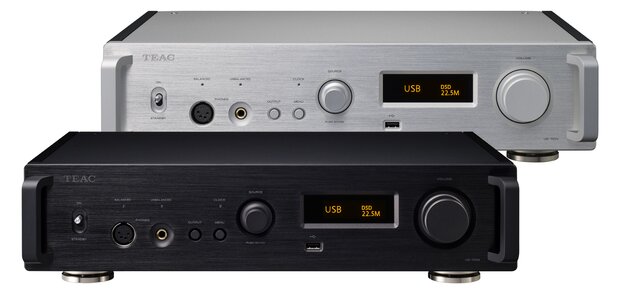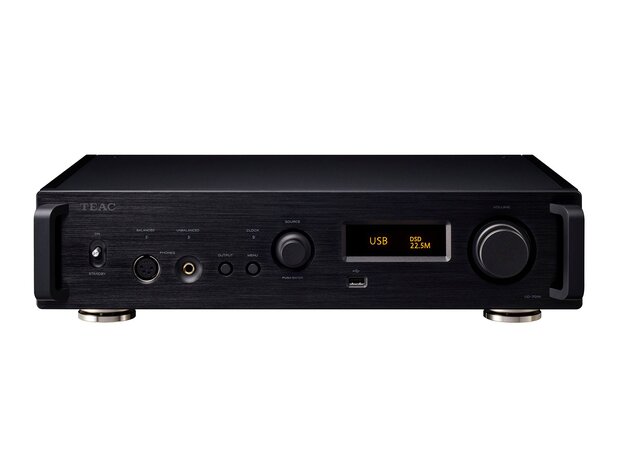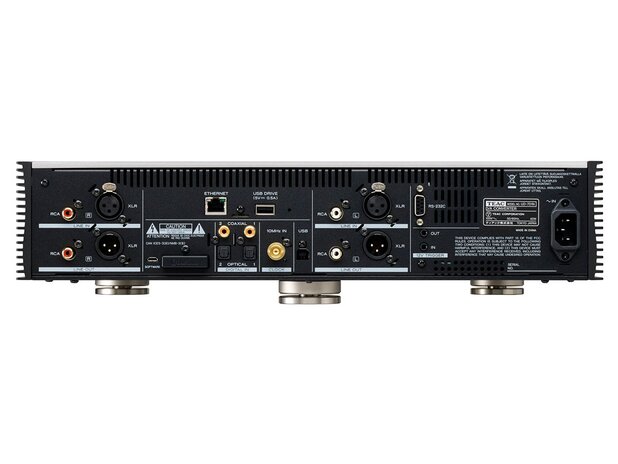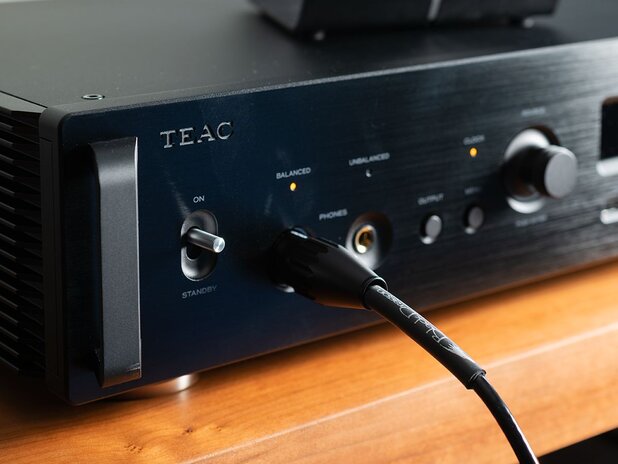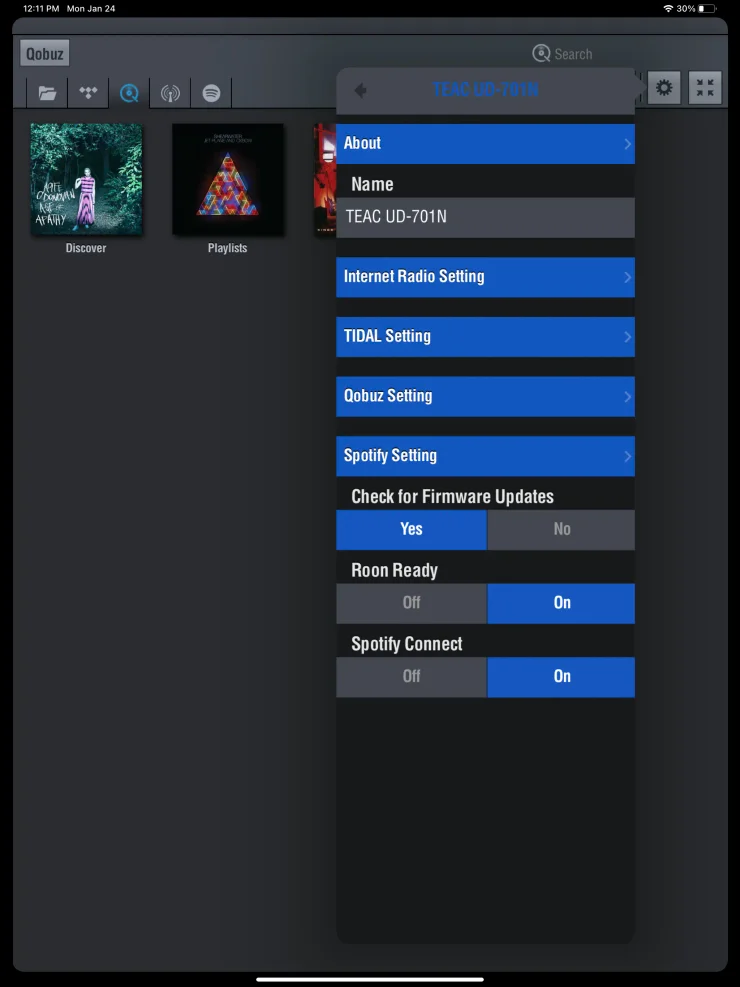

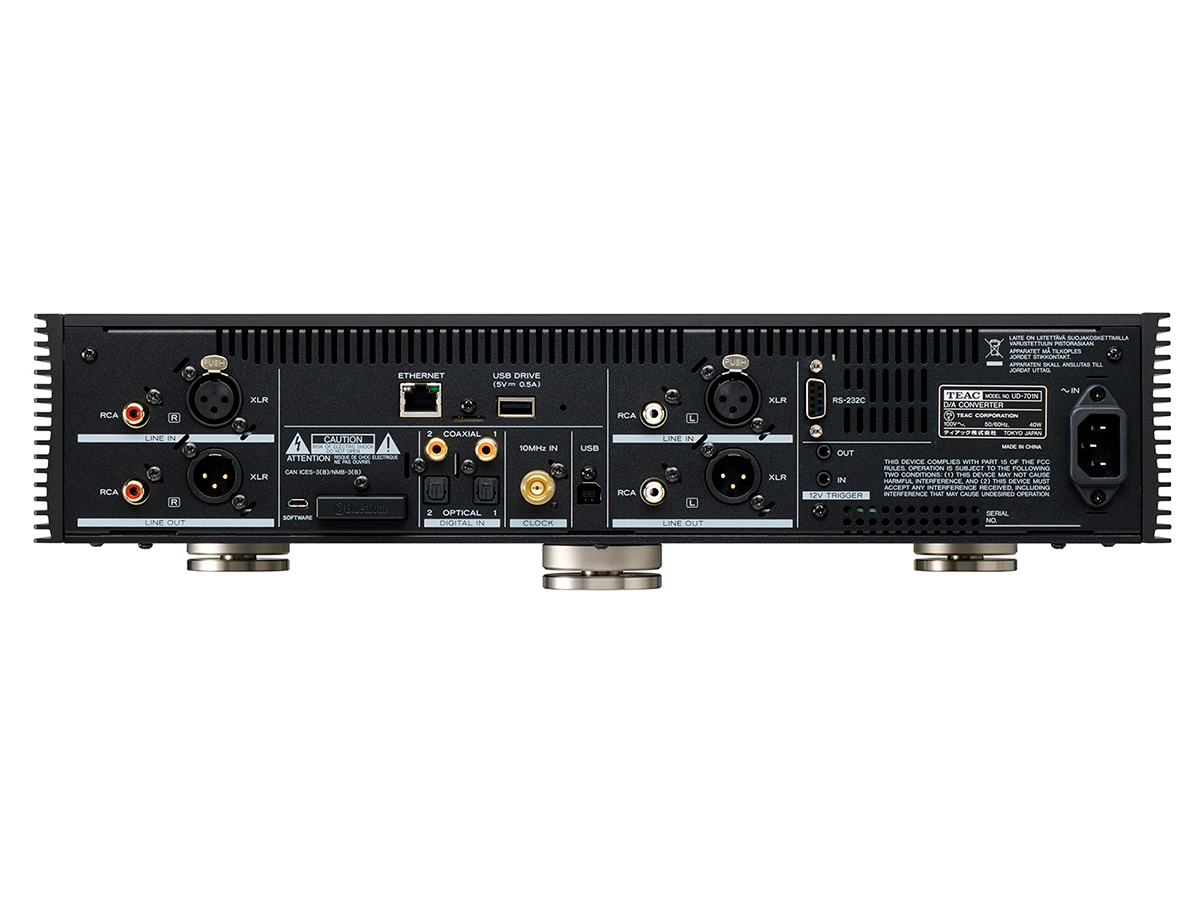

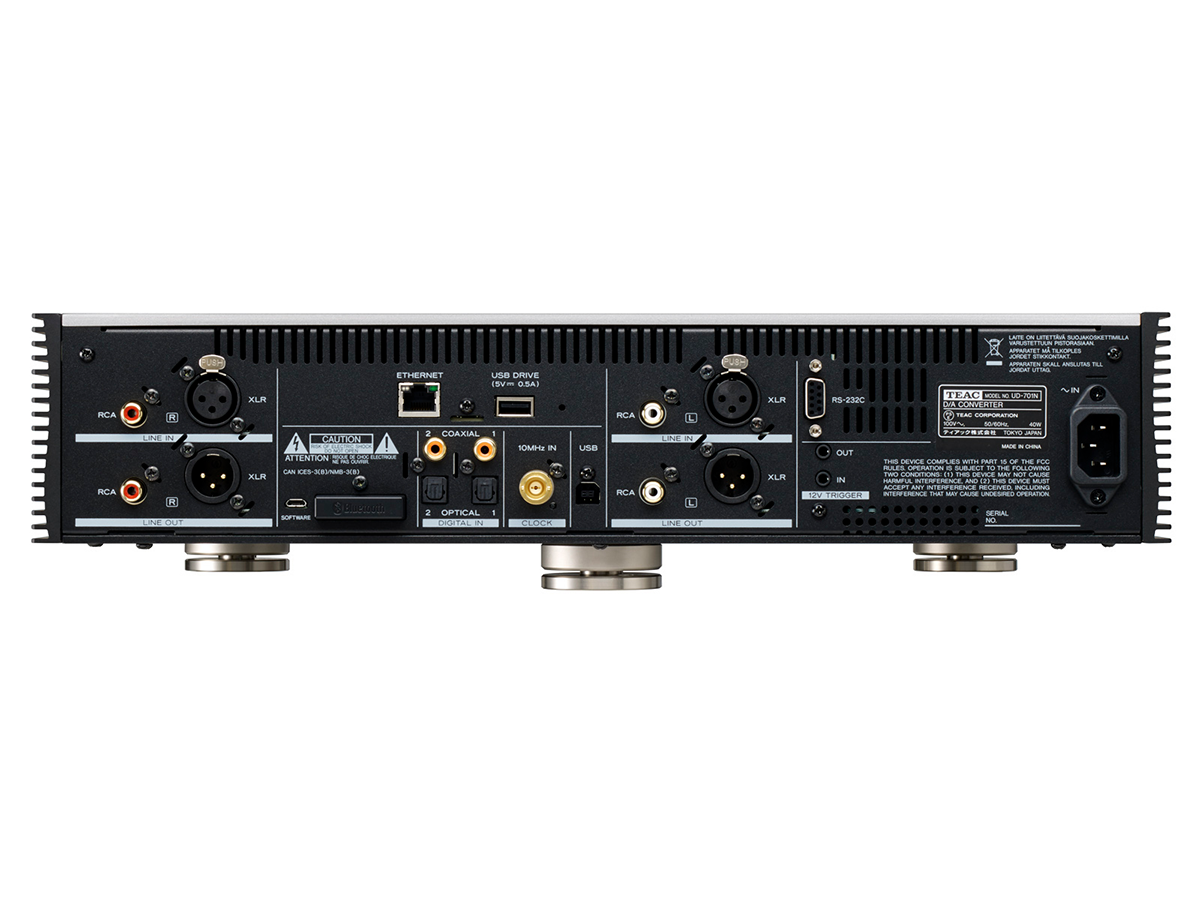






TEAC Audio
UD-701N Headphone Amplifier, USB DAC and Network Player
$3,870.00 USD
Features
Dual mono, fully-balanced circuit structure realizes outstanding channel separation
Playback of 22.5MHz DSD and 384kHz/32-bit PCM is possible as a USB DAC and network player
Preamp function with four digital inputs and two pairs of RCA/XLR line inputs
4-pin XLR headphone amplifier that can be switched between balanced and active ground
MQA full decoder function that also supports digital inputs of CD Player
Upconversion to 2/4/8× sampling frequencies using RDOT-NEO
Bluetooth® receiver supports LDAC, aptX™ HD, and other high-resolution codecs
Conforms to OpenHome standards and supports Roon Ready
Supports Spotify Connect, Tidal, Qobuz, and TuneIn (Internet Radio)
Unique TEAC-HCLD2 enhanced-current output buffer circuits
Analog preamp circuits with high resolution using TEAC-QVCS
What's in the Box?
Warranty
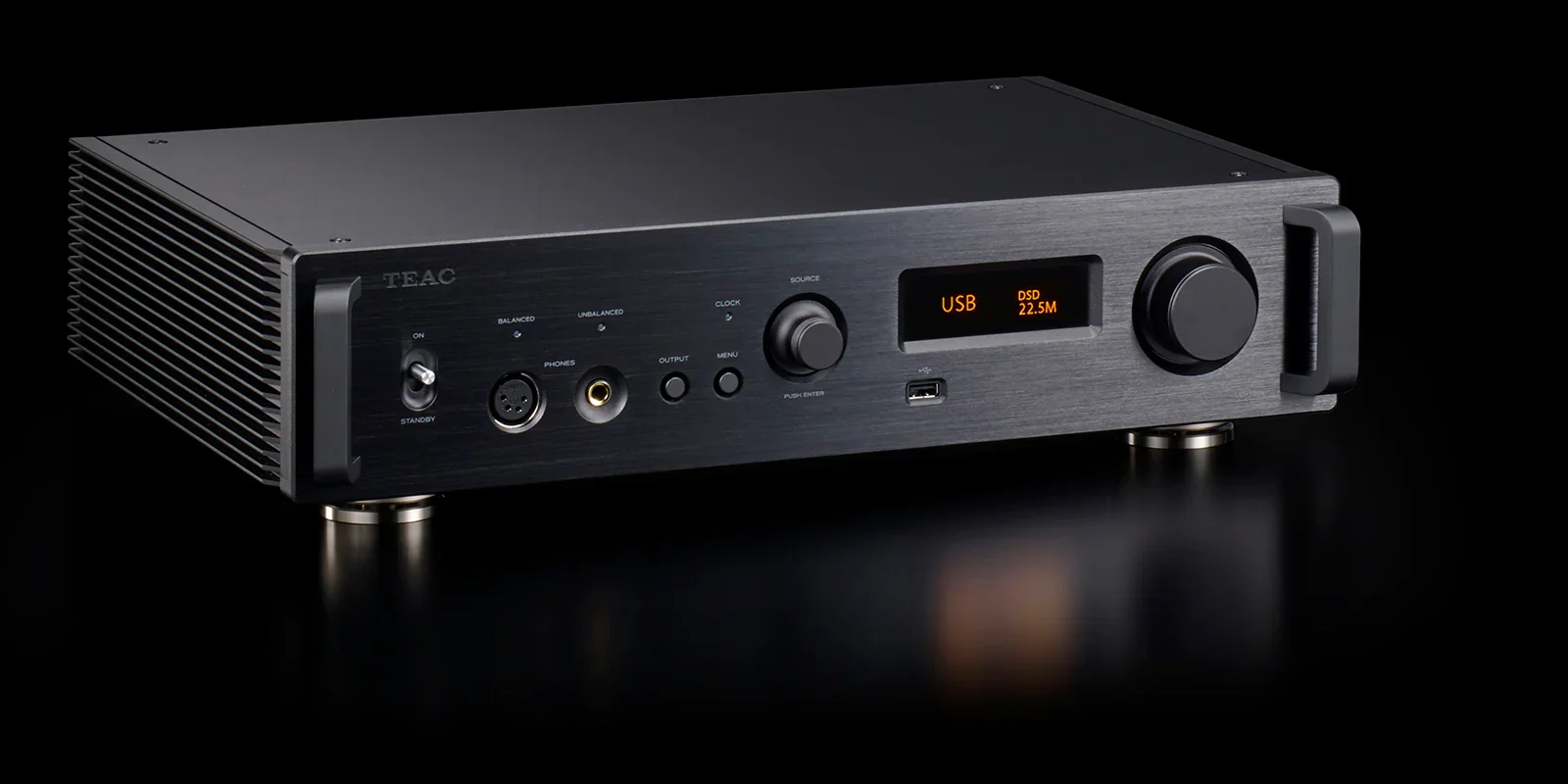
With a newly developed original discrete DAC, this advanced all-around unit fascinates every audiophile as the core of an audio system.
With USB DAC functions as the foundation, a network player, an analog preamp, a headphone amplifier, and various other functions have been combined at a high level. This TEAC flagship with a newly developed TEAC ΔΣ (Delta Sigma) discrete DAC has achieved a new level. As a USB DAC and network player, 22.5MHz DSD and 384kHz/32-bit PCM are supported. Using the newly developed TEAC ΔΣ discrete DAC, all digital signals are converted to analog signals with high audio quality. Not only can this be used for all kinds of digital playback, from systems centered on a PC or Mac to audio server systems using NAS and streaming playback, but it can also fulfill a core role in systems as a preamp with analog and digital inputs. The UD-701N is an all-around unit that flexibly supports new listening styles in a new age. Along with allowing listening through speakers in combination with a power amplifier, it also supports balanced headphone output using a 4-pin XLR jack.
A versatile all-round unit matches new listening styles in a new era.
Newly-developed TEAC ΔΣ Delta Sigma discrete DAC
Instead of using a generic DAC IC, we incorporated a newly developed TEAC ΔΣ (Delta Sigma) discrete DAC comprised of discrete circuitry that uses an FPGA incorporating our original algorithms. Analog signals are output with high audio quality. DSD signals are transmitted as is, while PCM signals are transmitted after passing through the ΔΣ modulator and conversion to either 1-bit or multi-bit signals, according to the end users'choiceg. We can say that achieving this wide, clear sound field, which can be realized specifically because of the discrete design, is TEAC reaching the pinnacle of its sound objectives. With the TEAC ΔΣ discrete DAC, playback of 22.5MHz DSD and 384kHz/32-bit PCM is possible.
Dual mono structure
We have incorporated an extravagant dual mono structure throughout the unit, from the power circuit with independent left and right toroidal core transformers to the D/A converter section and analog output stage. This dual model structure, which has complete mono circuits for each of the two channels, prevents interference between the left and right channels, enabling the realization of rich musical expression that reproduces the sense of space and dimension.
Fully-balanced transmission at every stage
The fully balanced transmission of both the left and right analog output signals from after D/A conversion through the final output stage contributes greatly to improving the signal-to-noise ratio and increasing the dynamic range. This conveys signals in a purer state without losing the sense of air that high-resolution audio sources have.
*The circuit boards in these photos are under development.
Four high-capacity toroidal core transformers
In addition to the 2 toroidal core transformers for the independent left and right analog signals, separate toroidal core transformers are also used in both the network module and digital control sections. In particular, stable electricity is supplied to the network module, which requires advanced processing, by strengthening the power supply for the network module section with linear power.
Analog preamplifier function with 2 line inputs via RCA/XLR and 4 digital inputs
Not only as a USB DAC/Network player that employs two sets of coaxial andoptical digitala inputs, the UD-701N also works as a high-quality analog preamplifier by employing additional analog audio inputs via RCA and XLR connectors that allow users to connect conventional audio sources. Our TEAC-QVCS (Quad Volume Control System) is a variable gain amp volume control with four independent circuits for left, right, positive, and negative (L+, L−, R,+, and R−). Placing this in the audio signal route makes it as short as possible, preventing the degradation of audio signals caused by drawing them through signal lines. Moreover, since the volume can be adjusted in extremely fine 0.5dB intervals, you can achieve the ideal volume for the audio system or headphones that you are using.
Improved TEAC-HCLD2 enhanced-current output buffer circuits
We used TEAC-HCLD2 circuits, which are improved versions of our TEAC-HCLD (TEAC High Current Line Driver) enhanced-current output buffer circuits. These raise the current transmission capabilities that are important in analog output circuits. Each channel has a positive and negative two-circuit structure with diamond buffer amplifiers, which have high current transmission capabilities, used as line drivers. Drive is differential for balanced output and parallel for unbalanced output. By increasing the current supply ability, transmitting the dynamism of audio signals without loss becomes possible.

4-pin XLR headphone amplifier that can be switched between balanced and active ground
A total of four diamond buffers, one in each of the left, right, positive, and negative circuits, are used in the dedicated headphone amplifier, enabling the connection of balanced drive headphones. Moreover, even during single-end use, by driving these amps in parallel, they can provide a stronger drive than ordinary single-end headphone amplifiers. This enables the potential of many types of headphones, including 600Ω high-impedance headphones, to be realized. Active ground is a drive method, based on the principles of a balanced connection, that approaches 0 V by connecting the COLD connector to the ground and driving the ground forcibly using an amplifier circuit. Not only can a more ideal ground be realized than when using an ordinary ground, but the impact of humming noise coming from the power can also be suppressed. Moreover, by lowering the noise floor, we can expect silence to be deepened, allowing the breathing of the artists and the texture of sounds to be felt more intimately.

MQA full decoder that also supports digital inputs
MQA (Master Quality Authenticated) is a high-quality audio codec that enables playback at the same quality level as studio masters. The UD-701N features an MQA decoder that precisely controls D/A-converted waveforms, with a resolution of 5 ms or finer, to achieve analog waveforms that are true to the original recordings. Playback sound that seems like the original to the human ear can be achieved by greatly reducing the “sound blurring” that occurs easily when sounds start suddenly and at other times when sound pressure differences are extreme. Since a full decoder is included, in addition to file and network playback, MQA data from digital inputs can also be decoded. Playback of MQA CDs is possible by connecting the digital output of a CD player to the UD-701N.
Upconversion
The upconversion function uses RDOT-NEO (Refined Digital Output Technology NEO) to smoothly augment PCM digital audio signals and upconvert their sampling frequencies 2, 4, or 8 times (384kHz maximum). RDOT, which applies an analogous interpolation method using fluency logic, is a technology that was developed to enable reproduction and playback of frequencies higher than 20 kHz that are lost by 44.1kHz/48kHz digital signals. Based on the information read, analogous data is generated between the waveform samples, which also results in data above 20 kHz.
Bluetooth® receiver supports LDAC, aptX™ HD, and other high-resolution transmission formats.s
In addition to the LDAC and LHDC codecs, which can transmit audio data with a quality considered high resolution (96kHz/24-bit), it also supports Qualcomm aptX HD, capable of 48kHz/24-bit transmission. Of course, the popular AAC, Qualcomm® aptX™, and SBC codecs are also supported, so you can easily enjoy high-quality wireless playback from smartphones and digital audio players.
Support for popular and convenient network functions, including OpenHome and Roon Ready
Common control apps that support OpenHome can be used with the UD-701N, which also supports this platform. Moreover, playlists on the UD-701N can be managed using TEAC HR Streamer and other control apps that support OpenHome. Gapless playback is also supported. With support for Roon Ready, functions provided by RAAT (Roon Advanced Audio Transport), including high-quality audio playback, easy and convenient operation using apps, and multi-room synchronized playback, can be used without limits.
* Support for Roon Ready will be added in a firmware update made available after product release.
Spotify Connect, Tidal, Qobuz, and TuneIn (Internet Radio)
Along with Spotify Connect, this model also supports Tidal and Qobuz, which are subscription music streaming services that enable listening to lossless CD-quality (44.1kHz/16-bit) recordings.
* Tidal Connect will be added in a firmware update made available after product release.
Bulk Pet USB transfer technology enables stable data transmission.
When transmitting large amounts of digital data by USB cable from high-resolution audio sources, large inconsistencies arise in the processing loads of both the sending computer and the receiving USB DAC, and audio dropouts and other problems can occur. Using the Bulk Pet USB transfer technology, however, the same amount of data is transmitted at a steady rate, leveling the processing loads of both sides and realizing stable data transmission. Since changes in computer load conditions can also affect audio quality, you can select from four preset transmission modes to choose the preferred audio quality.
Design features to prevent vibration
A floating structure is utilized to keep transformers, which can easily cause vibrations, isolated from the bottom panel. The lengths of all the side fins, which are for heat dispersion, have also been adjusted to prevent sympathetic vibrations.
In addition to using the minimum number of circuit board attachment screws, TEAC original pinpoint feet that utilize a new mechanism to provide play where they contact the bottom panel are used to thoroughly suppress vibrations that affect audio quality.
TEAC HR Audio Player, which supports 22.5MHz DSD playback with both Windows and Mac, is provided for free
This free dedicated software can be used to easily play 22.5Mhz DSD and 384kHz/32-bit PCM, which represent the next generation of high-resolution audio sources, from Windows and Macintosh computers. By simply starting the software and selecting the UD-701N connected by a USB cable, digital audio data can be transmitted reliably under optimal conditions. Since this software is designed for use with this model, there is no need to worry about the troubles that often occur with USB audio settings, including “no sound being output even when the USB DAC is recognized” and “sound being down-converted when it is output.”
TEAC HR Streamer, which enables high-resolution playback from smartphones and tablets, is provided for free
We have prepared the Teac HR Streamer, a network control app of our own design, that supports Open Home. With the ability to make libraries by loading artwork and music tag data from song data already stored on NAS, intuitive and quick track selection operations are possible. Furthermore, you can select tracks and add them to playlists as you like, crossing freely between cloud services and local networks, including audio files stored on NAS and USB flash drives, as well as FLAC and MQA sources on Tidal and Qobuz. TEAC HR Streamer can be used on iOS and Android devices.
Features at a glance
- Newly-developed TEAC ΔΣ (Delta Sigma) discrete DAC
- Dual mono, fully-balanced circuit structure realizes outstanding channel separation
- Playback of 22.5MHz DSD and 384kHz/32-bit PCM is possible as a USB DAC and network player
- Preamp function with four digital inputs and two pairs of RCA/XLR line inputs
- 4-pin XLR headphone amplifier that can be switched between balanced and active ground
- MQA full decoder function that also supports digital inputs of the CD Player
- Upconversion to 2/4/8× sampling frequencies using RDOT-NEO
- Bluetooth® receiver supports LDAC, aptX™ HD, and other high-resolution codecs
- Conforms to OpenHome standards and supports Roon Ready
- Supports Spotify Connect, Tidal, Qobuz, and TuneIn (Internet Radio)
- Unique TEAC-HCLD2 enhanced-current output buffer circuits
- Analog preamp circuits with high resolution using TEAC-QVCS
*Roon Ready and Tidal Connect will be supported by a future firmware update.
What's in the box?
- Power cord
- Remote control (RC-1330)
- AAA batteries × 2
- Owner's manual
| Parameter | Specification |
|---|---|
| Physical Specifications | |
| Overall Dimensions | 444 (W) × 111 (H) × 334 (D) mm (including protrusions) |
| Weight | 11.8 kg |
| Operating Temperature | +5°C to +35°C |
| Operating Humidity Range | 5% to 85% (no condensation) |
| Storage Temperature Range | -20°C to +55°C |
| Technical Specifications | |
| DAC | TEAC ΔΣ Discrete DAC × 2 |
| Upconvert | 2xFs / 4xFs / 8xFs (maximum 384kHz) |
| USB Connection | USB B-type × 1 (USB2.0 compliant) |
| USB PCM Formats | 16/24/32 bit, 44.1k/48k/88.2k/96k/176.4k/192k/352.8k/384kHz |
| USB DSD Formats | 2.8M/5.6M/11.2M/22.5MHz |
| Coaxial Connectors | RCA Pin (gold-plated) × 2 pairs |
| Coaxial Input | 0.5Vp-p, 75Ω impedance |
| Coaxial PCM Formats | 16/24 bit, 32k/44.1k/48k/88.2k/96k/176.4k/192kHz |
| Coaxial DSD Formats | 2.8MHz (176.4kHz/24bit DoP format) |
| Optical Connectors | Rectangular (TOS) × 2 pairs |
| Optical Input Level | -24.0 to -14.5dBm peak |
| Optical PCM Formats | 16/24 bit, 32k/44.1k/48k/88.2k/96k/176.4k/192kHz |
| Optical DSD Formats | 2.8MHz (176.4kHz/24bit DoP format) |
| Ethernet Connector | RJ-45 × 1 (1000Base-T) |
| Ethernet PCM Formats | 16/24/32 bit, 32k/44.1k/48k/88.2k/96k/176.4k/192k/352.8k/384kHz (Stereo) |
| Ethernet DSD Formats | 2.8M/5.6M/11.2M/22.5MHz (Stereo) |
| Network PCM Lossless | FLAC, Apple Lossless (ALAC), WAV, AIFF, MQA |
| Network DSD Lossless | DSF, DSDIFF (DFF), DoP |
| Network Compressed Audio | MP3, AAC (m4a container) |
| USB Flash Drive Connectors | USB A-type × 2 (Front × 1, Rear × 1, USB2.0 compliant) |
| USB Drive File System | FAT32, exFAT and NTFS single partition |
| USB Drive PCM Formats | 16/24/32 bit, 32k/44.1k/48k/88.2k/96k/176.4k/192k/352.8k/384kHz (Stereo) |
| USB Drive DSD Formats | 2.8M/5.6M/11.2M/22.5MHz (Stereo) |
| USB Drive PCM Lossless | FLAC, Apple Lossless (ALAC), WAV, AIFF, MQA |
| USB Drive DSD Lossless | DSF, DSDIFF (DFF), DoP |
| USB Drive Compressed Audio | MP3, AAC (m4a container) |
| Clock Sync Input Connector | BNC (gold-plated) × 1 |
| Clock Sync Input Frequency | 10MHz |
| Clock Sync Input Impedance | 50Ω |
| Clock Sync Rectangle Wave | Equivalent to TTL |
| Clock Sync Sine Wave | 0.5 to 1.0 Vrms |
| Trigger Input Connector | 3.5mm Mono mini jack × 1 (12V TRIGGER IN) |
| Trigger Input Level | 12V, 1mA |
| Trigger Output Connector | 3.5mm Mono mini jack × 1 (12V TRIGGER THRU) |
| Trigger Output Level | 12V |
| Maximum Trigger Current | 100mA |
| Power Supply | AC 120V, 60Hz (US/Canada), AC 230V, 50Hz (UK/Europe) |
| Power Consumption | 40W |
| Standby Power | 0.4W |
| Audio Specifications | |
| Frequency Response | 5Hz to 80,000Hz (+1dB/-5dB) |
| Total Harmonic Distortion | 0.01% (1kHz, LPF: 20 to 20kHz) |
| S/N Ratio | 110dB (A-Weight, IHF-A) |
| Measurement Conditions | Input signal: 192kHz/24-bit PCM, Measurement output: RCA, DAC low-pass filter: On |
| Balanced Input Connectors | XLR × 1 pair |
| Balanced Input Impedance | 50kΩ |
| Balanced Maximum Input Level | 5Vrms |
| Unbalanced Input Connectors | RCA Pin (gold-plated) × 1 pair |
| Unbalanced Input Impedance | 25kΩ |
| Unbalanced Maximum Input Level | 2.5Vrms |
| Bluetooth Version | 4, Class2 (range: 10m) |
| Bluetooth Profile | A2DP, AVRCP |
| Bluetooth A2DP Codec | LDAC, LHDC, AAC, SBC, Qualcomm® aptX™ audio/HD audio |
| Bluetooth Content Protection | SCMS-T |
| Bluetooth Saved Pairings | Maximum 8 |
| Balanced Output Connectors | XLR (gold-plated pins) × 1 pair |
| Balanced Output Impedance | 220Ω |
| Balanced Output Level Settings | Selectable from Fixed (0dB), Fixed (+6dB), Variable, or Off |
| Balanced Maximum Output Level | 2.0Vrms (1kHz, Full-scale, 10kΩ loaded, Fixed at 0dB) 4.0Vrms (1kHz, Full-scale, 10kΩ loaded, Fixed at +6dB) 12Vrms (1kHz, Full-scale, 10kΩ loaded, Variable) |
| Unbalanced Output Connectors | RCA Pin (gold-plated) × 1 pair |
| Unbalanced Output Impedance | 180Ω |
| Unbalanced Output Level Settings | Selectable from Fixed (0dB), Fixed (+6dB), Variable, or Off |
| Unbalanced Maximum Output Level | 2.0Vrms (1kHz, Full-scale, 10kΩ loaded, Fixed at 0dB) 4.0Vrms (1kHz, Full-scale, 10kΩ loaded, Fixed at +6dB) 6.0Vrms (1kHz, Full-scale, 10kΩ loaded, Variable) |
| Headphone Balanced Connector | 4-pin XLR × 1 |
| Headphone Balanced Pin Assign | Pin1: L+, Pin2: L–, Pin3: R+, Pin4: R– |
| Headphone Unbalanced Connector | 6.3mm Stereo jack (gold-plated) × 1 |
| Headphone Maximum Output (Balanced) | 700mW + 700mW (32Ω loaded) |
| Headphone Maximum Output (Unbalanced) | 500mW + 500mW (32Ω × 1 loaded) |
| Supported Headphone Impedance | 16 to 600Ω |







